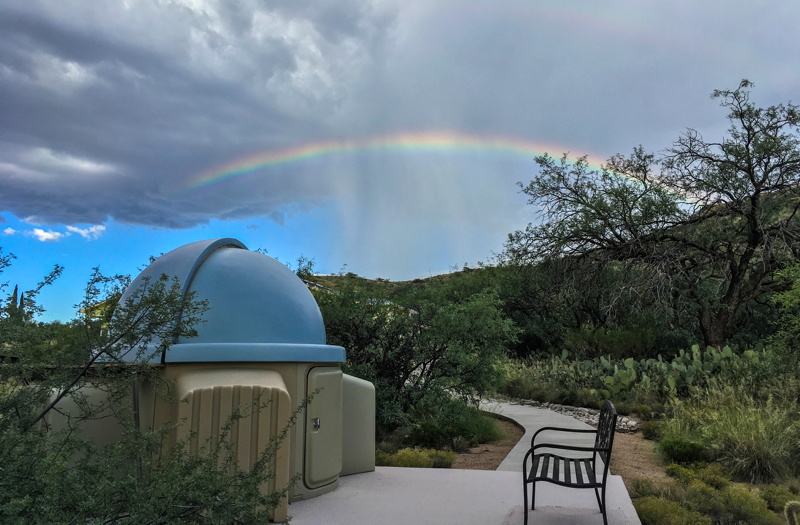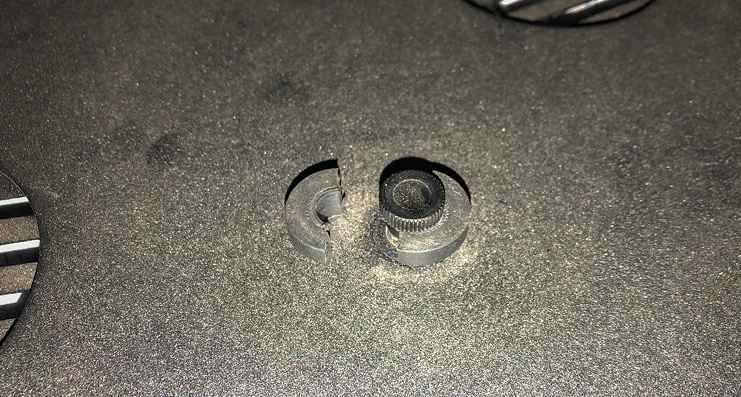Rainbow; Critter; Emmy Nomination;
Planets, Moon
Posted: 21 September 2018
Clouds began appearing mid-day on Friday, 14 September 2018. Didn't open the observatory that evening as the clouds were increasing as sunset approached. I checked the live animal trap by the observatory before sunset; the food was gone but the trap didn't trap. Put new food in it.
I got up early Saturday morning, 15 September, to try to photograph the launch of a Delta 2 rocket from Vandenberg AFB, CA. The launch was originally to be at 0546 MST but was delayed until 0602 MST. The delay allowed my western sky to get significantly brighter (sunrise at 0607 MST). There were some clouds along the western horizon. The launch was not seen. Clouds increased throughout the day.
The live animal trap had been tripped but no animal was caught. I checked again Saturday evening and an another (or the same) antelope squirrel was inside. Removed him. The sky was essentially overcast that night.
Due to a very early morning commitment Monday, 17 September, and clouds on Sunday, 16 September, I did not open the observatory Sunday night. However, I did get this photo of a rainbow:

While I was out taking rainbow photos I saw this Greater Horned Lizard:

On Monday, 17 September, I learned that my 2017 interview by Arizona Illustrated on Arizona Public Media was nominated for a 2018 Emmy Award!

Congratulations to Tony Paniagua and Sandra Westdahl. They were great to work with on the interview. The winner will be announced on Saturday, 22 September.
Tuesday, 18 September, began with a clear sky, but clouds appeared mid-day as our final Monsoon Season storm system approached. By sunset the sky was mostly cloudy:

Click or tap on image for larger version
Wednesday, 19 September, was cloudy with rain much of the day (0.74"). Thursday, 20 September, dawned mostly clear with a clear sky forecast for the night. Clouds began appearing mid-morning, reducing my hopes for a clear night, but the sky began clearing again mid-afternoon.
|
Open: Thursday, 20 September 2018, 1816 MST Temperature: 78°F |
Session: 1279 Conditions: Mostly clear, humid |
Equipment Used:
12" f/8 LX600 w/StarLock
2" 24mm UWA eyepiece
1.25" 26mm eyepiece
1.25" 9mm eyepiece
Camera:
iPhone 8 Plus
D850 DSLR
Before opening the dome I SYNCed the observatory clock to WWV time signals.
1826 MST: sunset.
1830 MST: LX600 ON, StarLock OFF, High Precision OFF.
Viewed the crescent Venus, low in the southwestern sky, 102X and 94X. Seeing was poor.
Mounted the iPhone 8 Plus on the 12" telescope and did some imaging of Venus. This is a stack of 314 video frames taken with NightCap Camera (ISO 80, 1/3205sec), afocal 271X:

1844 MST: viewed Jupiter, also low in the southwest, 102X and 94X. The four Galilean Moons were visible. This iPhone afocal 94X image taken with the Camera app shows the four moons:

I tried other imaging of Jupiter but seeing was not good enough.
1900 MST: stepped outside of the observatory and began setting up to image the sky using the D850 DSLR + 8mm fisheye lens. This f/16, 10 seconds, ISO 1600, photo shows the Moon, Mars, Saturn, Jupiter, Venus, and two planes:

Mouseover or tap on image for labels
1923 MST: returned to the observatory and viewed Saturn, 102X and 271X. Tried imaging but the results were not good due to the poor seeing.
Then viewed Mars, 102X and 271X. Seeing still was not good but I did manage to get this iPhone image, afocal 271X, stack of 167 video frames, NightCap Camera (ISO 100, 1/657sec):

The image shows a dark surface feature, the South Polar Cap, and some probable dust at the right side.
1950 MST: viewed the Moon, 102X and 94X. The Moon was too large to view the entire illuminated portion with the 26mm eyepiece (94X). The Moon was entirely visible using the 24mm UWA eyepiece (102X).
Took this handheld iPhone afocal 102X photo of the Moon using the Camera app:

This is the crater Gassendi (at left), iPhone afocal 271X, Camera app:

2010 MST: viewed the Double Cluster (open star clusters), 94X and 102X. Both clusters were not in the same field-of-view with the 26mm eyepiece but were with the 24mm UWA eyepiece.
2016 MST: GC Wi-Fi Adapter ON. Tested the iOS app ScopeBoss to ensure that it worked with iOS 12 on the iPhone 8 Plus. It did. 2021 MST: GC Wi-Fi Adapter OFF.
2023-2033 MST: I then did some tests of the just received Meade Stella Wi-Fi Adapter. I will report on the results in my upcoming review.
I heard the packrat outside of the observatory again this session. Will set up a live trap on the next session.
2039 MST: LX600 OFF. My logbook was damp from the high humidity.
|
Close: Thursday, 20 September 2018, 2050 MST Temperature: 69°F |
Session Length: 2h 34m Conditions: Clear, 69% humidity |
Recently, the rubber grommet on my AstroZap AstroCap split:

I contacted AstroZap and they immediately sent me a replacement.
Comments are welcome using Email. Twitter users can use the button below to tweet this report to their followers. Thanks.
Cassiopeia Observatory Home Page
Copyright ©2018 Michael L. Weasner / mweasner@me.com
URL = http://www.weasner.com/co/Reports/2018/09/21/index.html
